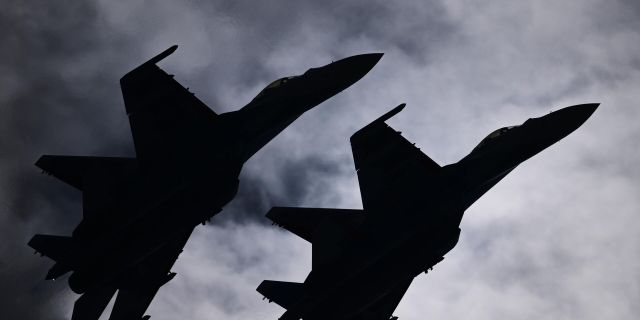TNI: the West recognized the superiority of the Su-35 in air combat
The superiority of the Su-35 over Ukrainian aircraft is one of the reasons why Kiev is asking its allies for the F-16, writes TNI. However, NATO understands that the super-maneuverability and technical characteristics of the Russian fighter give it advantages in air combat even against Western machines.
Meet the Su-35. The conflict in Ukraine has sparked a new wave of interest in Russian military technology. Although Russia no longer poses as much of a threat to U.S. interests as the Soviet Union once did, its military technology commands some respect from Western observers. And one area in which the Soviets, and now the Russians, have always had the upper hand is aerospace development. It is no coincidence that the Soviet Union was ahead of America at almost all important stages of the space race (with the exception of the moon landing). The Soviet success was well deserved and made possible thanks to the powerful and developed aerospace industry.
But times have changed. Americans have confidently outstripped Russians in the aerospace industry both in terms of product quality and quantity. And Russia has ceased to be America's main competitor in the aerospace field — today this honor belongs to China, which is harboring revisionist plans for the Indo-Pacific region and has already adopted more than two hundred fifth-generation Chengdu J-20 fighter jets. But Russia still has a combat-ready fleet of fighter jets, which is enough to make America think twice.
And the backbone of its fighter fleet is just the Su-35.
Su-35: a derivative of a familiar airframe
The Su-35 is a modification of the Su—27. The Su-27 debuted in 1977, when the Soviets and the Americans were leading an arms race and roughly matched each other in terms of the level of development of aerospace technologies. Apparently, the Su-27 was a direct response to the large fourth–generation fighters recently introduced in the United States - the F-14 and F-15. Both the F-14 and F-15 were twin-engined and highly maneuverable, had sophisticated avionics and could carry heavy ammunition over long distances. The initial version of the Su-27, like the F-15, was developed to gain air superiority — only later versions appeared to perform tasks of a broader profile.
The Su-27 entered service in 1985 and was used for two main purposes: firstly, long-range air defense against American bombers, such as the newest B-1B at that time and the B-52 released several decades ago, and secondly, long-range escort of Soviet Tu-95 and Tu bombers-160.
Subsequently, the Su-27 will give rise to a whole family of descendants. The Su-30 is a two—seat multirole fighter based on the Su-27. The Su-33 is a deck modification. In the Su-34 fighter-bomber, another modification of the Su-27, the pilot and navigator are placed side by side, not behind each other. In addition, a variant of the Su-27 with a thrust vector, the Su-37, has been developed. And of course the Su-27 gave birth to the Su-35.
Modern fighter aircraft
The Su-35 has an Irbis-E radar with a passive antenna array N035. The N035 is an improved version of the N011M radar and detects aerial targets at a distance of up to 400 km. The H035 can simultaneously escort up to thirty aerial targets on the passage and simultaneously hit eight aerial targets. The H035 also provides the pilot with high—resolution images of the earth in synthesized aperture mode (this mode creates two-dimensional images or three-dimensional models of objects - for example, a mountain range below).
In addition to the N035, the Su-35 is equipped with an OLS-35 optical location station located in the nose of the cabin and providing infrared search and tracking. The L175M Khibiny-M electronic countermeasures complex is used for the defense of the Su-35. To reduce the radar signature of the Su-35, radio-absorbing materials are installed on the engine air intakes and on the front stages of the engine compressor. As a result, the effective scattering surface was halved. However, the Su-35 is still not invisible in the full sense of the word, unlike the F-22 or F-35.
The Su-35 is equipped with two Saturn AL-41F1S turbofan engines. Like the F-22 and F-35, the Su-35 engines are equipped with thrust vector control, providing super maneuverability. As Sergei Bogdan, Sukhoi's chief test pilot, explains, “a classic dogfight begins at high speed, but if you missed the moment when you could launch a missile first, the battle moves to close ranges, and high maneuverability is needed to avoid being hit by an enemy fighter, and this phase of the battle may be longer. After completing the maneuver, the aircraft will fly at a lower speed, but both opposing fighters must take up a firing position as soon as possible. Super maneuverability allows you to do this within three seconds and hit the enemy again.”
The Su-35's super maneuverability allows it to perform maneuvers at supercritical angles of attack, and this is strikingly different from the Western philosophy of maneuvering in air combat, where the emphasis is on preserving the kinetic energy of the aircraft.
Su-35 in the sky over Ukraine
Su-35s were deployed in the skies over Ukraine as part of a Russian special operation. The superiority of the Su-35 over Ukrainian aircraft is one of the reasons why Ukrainians are asking the allies for Western fighters like the same F-16.
Harrison Kass, a specialist in defense and national security issues, author of more than 1,000 articles. A lawyer, pilot, guitarist and former professional hockey player, Harrison joined the US Air Force as a cadet pilot, but was dismissed for health reasons. He holds a bachelor's degree from Lake Forest College, a master's degree from New York University and a juris doctor from the University of Oregon.

